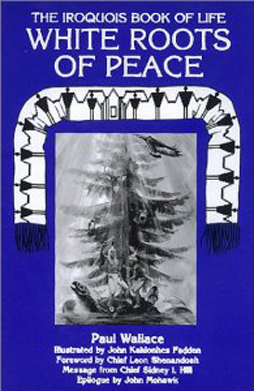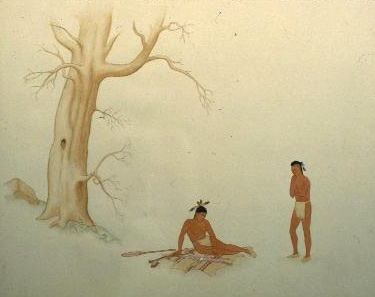The views expressed in our content reflect individual perspectives and do not represent the authoritative views of the Baha'i Faith.
For those of you who have followed this series of essays on Native American messengers of God, you’re already familiar with Deganawida, the Peacemaker.
The name, Deganawida, is considered by the Haudenosaunee (the “People of the Longhouse,” better-known to non-Natives as the Iroquois) as too sacred to say aloud. Instead, they refer to this great Native American Messenger of God respectfully as the “Peacemaker.”
Together with Hiawatha, the Peacemaker established the great League of Peace, uniting the “Five Nations” of the Mohawks, Oneidas, Cayugas, Onondagas, and Senecas.
One of the most famous episodes in the traditional Haudenosaunee cycle of sacred stories describes the Peacemaker’s encounter with a cannibal, about to eat his victim:
After Tekanawita [Deganawida] had departed in that direction he came to a house belonging to a cannibal who had his house there. Then Tekanawita went close to the house. Then, when he saw the man coming out, departing, sliding down the hill to the river, and dipping water, thereupon Tekanawita hurriedly climbed onto the house to the place where there was a chimney for the smoke to escape; he lay down on his stomach and looking into the house he saw that the task of breaking up meat and piling it up had been completed.
Then the man returned, and he was carrying a drum of water in it. Thereupon he poured it into a vessel, put meat into the liquid, and hung the vessel up over the fire until it boiled. Moreover, the man watched it, and when it was done, he took down the vessel placing it near the embers. Thereupon he said, “Now indeed it is done. Moreover, now I will eat.” Thereupon he set up a seat, a bench, thinking that he will put it on there when he eats. Thereupon he went to where the vessel sat, intending to take the meat out of the liquid, when he saw, from inside the vessel, a man looking out.
Thereupon he moved away without removing the meat, and sat down again on the long bench, for it was a surprise to him, seeing the man in the vessel. Thereupon he thought, “Let me look again.”
Thereupon he, Tekanawita, looked again from above where the smoke hole was, again causing a reflection in the vessel, and then the man, standing up again, went to where the vessel sat, looked into the vessel again, saw the man looking out, and he was handsome, he having a nice face. Thereupon the man moved away again and he sat down again on the long bench, and then he bowed his head, pondering and thinking, “I am exceedingly handsome and I have a nice face; it is probably not right, my habit of eating humans. So I will now stop, from now on I ought not kill humans anymore.” – Concerning the League, pp. 78–83.
 In this account, the cannibal remains unnamed. But, in the 1899 Gibson-Hewitt version, the Peacemaker names the cannibal “Hiawatha,” as also in the famous English version of the epic, White Roots of Peace, by Paul Wallace, first published in 1946.
In this account, the cannibal remains unnamed. But, in the 1899 Gibson-Hewitt version, the Peacemaker names the cannibal “Hiawatha,” as also in the famous English version of the epic, White Roots of Peace, by Paul Wallace, first published in 1946.
While the subject matter is grisly, the episode is as edifying as it is charming, especially for its insight into human nature. For we see that the cannibal believes the image reflected in his kettle, while simmering over the fire, is his very own reflection—male vanity, raw and uncooked. But he actually sees the image of the Peacemaker, looking down from above, as he peers through the smoke hole of the cannibal’s dwelling.
The cannibal makes the connection between himself and his hapless victim when he sees the Peacemaker’s reflection. The cannibal finally “gets it,” as he realizes and appreciates the humanity of his victim, his intended repast. No longer an object, the victim becomes a subject. Through this exquisite ruse, the Peacemaker teaches the cannibal a life-transforming message—to recognize the humanity of all people.
Thinking he is looking at himself, the cannibal suddenly sees himself within the social mirror of the world around him–a sad moment and a sudden enlightenment.
It took a Native Messenger of God to help the cannibal make this mental and emotional breakthrough. By seeing the humanity of others, the cannibal becomes human, and humane. The cannibal suddenly progresses from narcissism to compassion, from animal to angel, from sinner to saint.
Your hearts must be pure and your intentions sincere in order that you may become recipients of the divine bestowals. Consider that although the sun shines equally upon all things, yet in the clear mirror its reflection is most brilliant and not in the black stone. – Abdu’l-Baha, The Promulgation of Universal Peace, p. 92.
©2014 by Christopher Buck.

















Comments
Sign in or create an account
Continue with Googleor